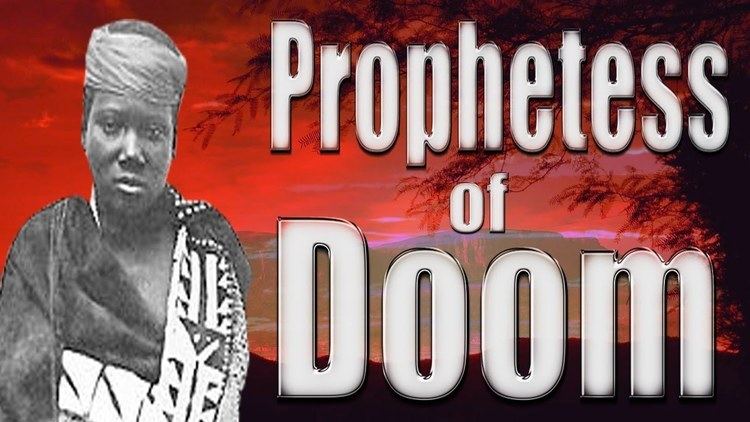Name Nongqawuse Nongqawuse Occupation Prophetess | ||
 | ||
Known for cattle-killing crisis of 1856–1857 Died 1898, Alexandria, South Africa | ||
Nongqawuse prophetess of doom
Nongqawuse ([noŋ̈͡ǃawuːse]; c. 1841 – 1898) was the Xhosa prophetess whose prophecies led to a millennialist movement that culminated in the Xhosa cattle-killing movement and famine of 1856-7, in what is now Eastern Cape, South Africa.
Contents
- Nongqawuse prophetess of doom
- Nongqawuse the prophetess of doom student intro film
- Personal life
- Spiritual experience
- Obeying the prophecy
- Aftermath
- References

Nongqawuse the prophetess of doom student intro film
Personal life

Nongqawuse was born in 1841 near Gxarha River in the independent Xhosaland close to the border of the recently colonized territory of British Kaffraria in South Africa. Little is known of Nongqawuse's parents as they died when she was young. According to Jeffrey B. Peires, Nongqawuse stated in a deposition that "Mhlakaza was my uncle....my father's name Umhlanhla of the Kreli tribe. He died when I was young." Nongqawuse’s parents died during the Waterkloof campaigns of the Eighth Frontier War (1850–1853). It is believed to have been quite conscious and aware of the tensions between the Xhosa and the colonial forces. The Xhosa were experiencing an onslaught of attacks upon their community and institutions by British colonial authorities from as early on as 1779. The orphaned Nongqawuse was raised by her uncle Mhlakaza, who was the son of a councillor of Chief Sarhili. Mhlakaza who was a religious man, who had returned to Xhosaland in 1853 after spending time in the Cape Colony and became familiar with Christianity, having left after his mother's death. Mhlakazi was to have a major influence in Nongqawuse's life acting as an interpreter and organiser of her visions.
Spiritual experience
In April 1856, 15-year old Nongqawuse and her friend Nombanda who was between the ages of 8-10 went to scare birds from her uncle's crops in the fields by the sea at the Gxara River mouth in the present day Wild Coast area of South Africa. When she returned, Nongqawuse told her uncle and guardian Mhlakaza, a Xhosa spiritualist, that she had met the spirits of three of her ancestors .
She claimed that the spirits had told her that the Xhosa people should destroy their crops and kill their cattle, the source of their wealth as well as food. Nongqawuse claimed that the ancestors who had appeared to them said.
In return the spirits would sweep the British settlers into the sea. The Xhosa would be able to replenish the granaries, and fill the kraals with more beautiful and healthier cattle. During this time many Xhosa herds were plagued with "lung sickness", possibly introduced by European cattle. Mhlakaza did not believe her at first but when Nongqawuse described one of the men, her uncle Mhalakaza, himself a diviner, recognised the description as that of his dead brother, and became convinced she was telling the truth.
Obeying the prophecy
Mhlakaza repeated the prophecy to paramount chief Sarili kaHintsa. Chief Sarhili sent emissaries to investigate the claims but they did not actually meet the strangers, but returned home convinced of the truth of the prophecies. Sarhili then sent two of his councillors to notify the chiefs under British jurisdiction that they must sacrifice their 'bewitched' cattle. After Sarhili had ordered his followers to obey the prophecy, the cattle-killing movement to spread to an unstoppable point. The cattle-killing frenzy affected not only the Gcaleka, Sarhili's clan, but the whole of the Xhosa nation. Historians estimate that the Gcaleka killed between 300,000 and 400,000 head of cattle. Not all Xhosa people believed Nongawuse's prophecies. A small minority, known as the amagogotya (stingy ones), refused to slaughter and neglect their crops, and this refusal was used by Nongqawuse to rationalize the failure of the prophecies over a period of fifteen months (April 1856–June 1857).
Aftermath
Nongqawuse predicted that the ancestors' promise would be fulfilled on February 18, 1857, when the sun would turn red. On that day the sun rose the same colour as every other day, and the prophecy was not realised. Initially, Nongqawuse's followers blamed those who had not obeyed her instructions, but they later turned against her. Sarhili visited the Gxarha River mouth, and spoke with Nongqawuse and Mhalakaza. When he returned, he announced that the New World would begin in eight days. On the eighth day the sun would rise, blood-red, and before setting again, there would be a huge thunderstorm, after which "The dead would arise". During the next eight days the Cattle- Killing rose to a climax. These prophecies also failed to come true leading to the death of many people. In the aftermath of the crisis, the population of British Kaffraria dropped from 105,000 to fewer than 27,000 due to the resulting famine.The chief of Bomvana handed Nongqawuse over to Major Gawler and she stayed at his home for a period. [15] One day Mrs Gawler decided to dress her, along with the Mpongo prophetess Nonkosi, and have their portrait taken by a photographer. [16] This is the widely circulated image of Nongqawuse with which most people are familiar.. After her release, she lived on a farm in the Alexandria district of the eastern Cape. She died in 1898.
Today, the valley where Nongqawuse met the spirits is still called Intlambo kaNongqawuse (Xhosa for Valley of Nongqawuse).
